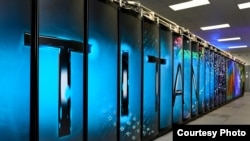Scientists at the Oak Ridge National Laboratory in the U.S. state of Tennessee have unveiled what could be the world’s fastest supercomputer.
The new computer, named Titan, is capable of making more than 20,000 trillion calculations each second (20 petaflops), according to officials at the Oak Ridge National Laboratory (ORNL). That is roughly equivalent to each of the world’s seven billion people being able to carry out three million calculations per second, according to ORNL. Titan also has more than 700 terabytes of memory.
“The numbers just end up so big that I struggle to come up with a way to explain it,” said Buddy Bland, the project director of ORNL’s Leadership Computing Facility. “It’s unimaginable. Twenty petaflops is [the number] 20 followed by 15 zeros.”
Titan is actually an upgrade to ORNL’s previous world’s best supercomputer, Jaguar. According to Bland, The new unit is roughly the same size as Jaguar, but is 10 times more powerful. Its components occupy a space about the area of a basketball court and are about two and a half meters high.
Titan, which cost $100 million, according to ORNL officials, is expected to be useful for researchers in numerous fields.
"Titan will allow scientists to simulate physical systems more realistically and in far greater detail," said James Hack, director of ORNL's National Center for Computational Sciences. "The improvements in simulation fidelity will accelerate progress in a wide range of research areas such as alternative energy and energy efficiency, the identification and development of novel and useful materials, and the opportunity for more advanced climate projections."
Bland said there have been direct commercial benefits as a result of such supercomputers.
He said one company, BMI Corporation, used Jaguar to design and develop airfoils for large trucks that make them more aerodynamic and fuel efficient.
In basic science, supercomputers have also helped scientists determine why neutron stars spin they way they do, Bland said.
Titan is the latest entrant in the race to have the world’s fastest supercomputer. It is expected to vie for the number one spot on the top 500 supercomputer list against Sequoia, which claimed the title last June.
China and Japan have both fielded computers in the top five.
“High performance computing is a game of leapfrog,” said Bland. “Every country in the world recognizes this is important. It’s important for our national competitiveness to be on the high end. Having the best tools means you get the best science.”
Bland said supercomputers are butting up against the same technological problems facing home computers.
“We use the same chips to build supercomputers that are in high-end computers at home,” he said. “These are not custom made chips for supercomputers. Processors haven’t gotten faster since 2002 or 2003. There are just more of them.”
Energy consumption is a challenge to powerful supercomputers, but officials at ORNL say Titan will only use “marginally more” electricity than Jaguar.
The new computer, named Titan, is capable of making more than 20,000 trillion calculations each second (20 petaflops), according to officials at the Oak Ridge National Laboratory (ORNL). That is roughly equivalent to each of the world’s seven billion people being able to carry out three million calculations per second, according to ORNL. Titan also has more than 700 terabytes of memory.
“The numbers just end up so big that I struggle to come up with a way to explain it,” said Buddy Bland, the project director of ORNL’s Leadership Computing Facility. “It’s unimaginable. Twenty petaflops is [the number] 20 followed by 15 zeros.”
Titan is actually an upgrade to ORNL’s previous world’s best supercomputer, Jaguar. According to Bland, The new unit is roughly the same size as Jaguar, but is 10 times more powerful. Its components occupy a space about the area of a basketball court and are about two and a half meters high.
Titan, which cost $100 million, according to ORNL officials, is expected to be useful for researchers in numerous fields.
"Titan will allow scientists to simulate physical systems more realistically and in far greater detail," said James Hack, director of ORNL's National Center for Computational Sciences. "The improvements in simulation fidelity will accelerate progress in a wide range of research areas such as alternative energy and energy efficiency, the identification and development of novel and useful materials, and the opportunity for more advanced climate projections."
Bland said there have been direct commercial benefits as a result of such supercomputers.
He said one company, BMI Corporation, used Jaguar to design and develop airfoils for large trucks that make them more aerodynamic and fuel efficient.
In basic science, supercomputers have also helped scientists determine why neutron stars spin they way they do, Bland said.
Titan is the latest entrant in the race to have the world’s fastest supercomputer. It is expected to vie for the number one spot on the top 500 supercomputer list against Sequoia, which claimed the title last June.
China and Japan have both fielded computers in the top five.
“High performance computing is a game of leapfrog,” said Bland. “Every country in the world recognizes this is important. It’s important for our national competitiveness to be on the high end. Having the best tools means you get the best science.”
Bland said supercomputers are butting up against the same technological problems facing home computers.
“We use the same chips to build supercomputers that are in high-end computers at home,” he said. “These are not custom made chips for supercomputers. Processors haven’t gotten faster since 2002 or 2003. There are just more of them.”
Energy consumption is a challenge to powerful supercomputers, but officials at ORNL say Titan will only use “marginally more” electricity than Jaguar.





